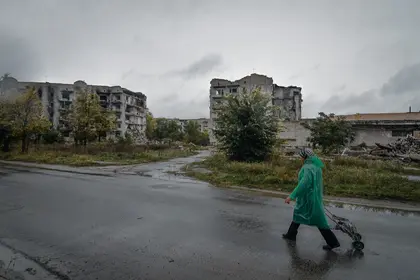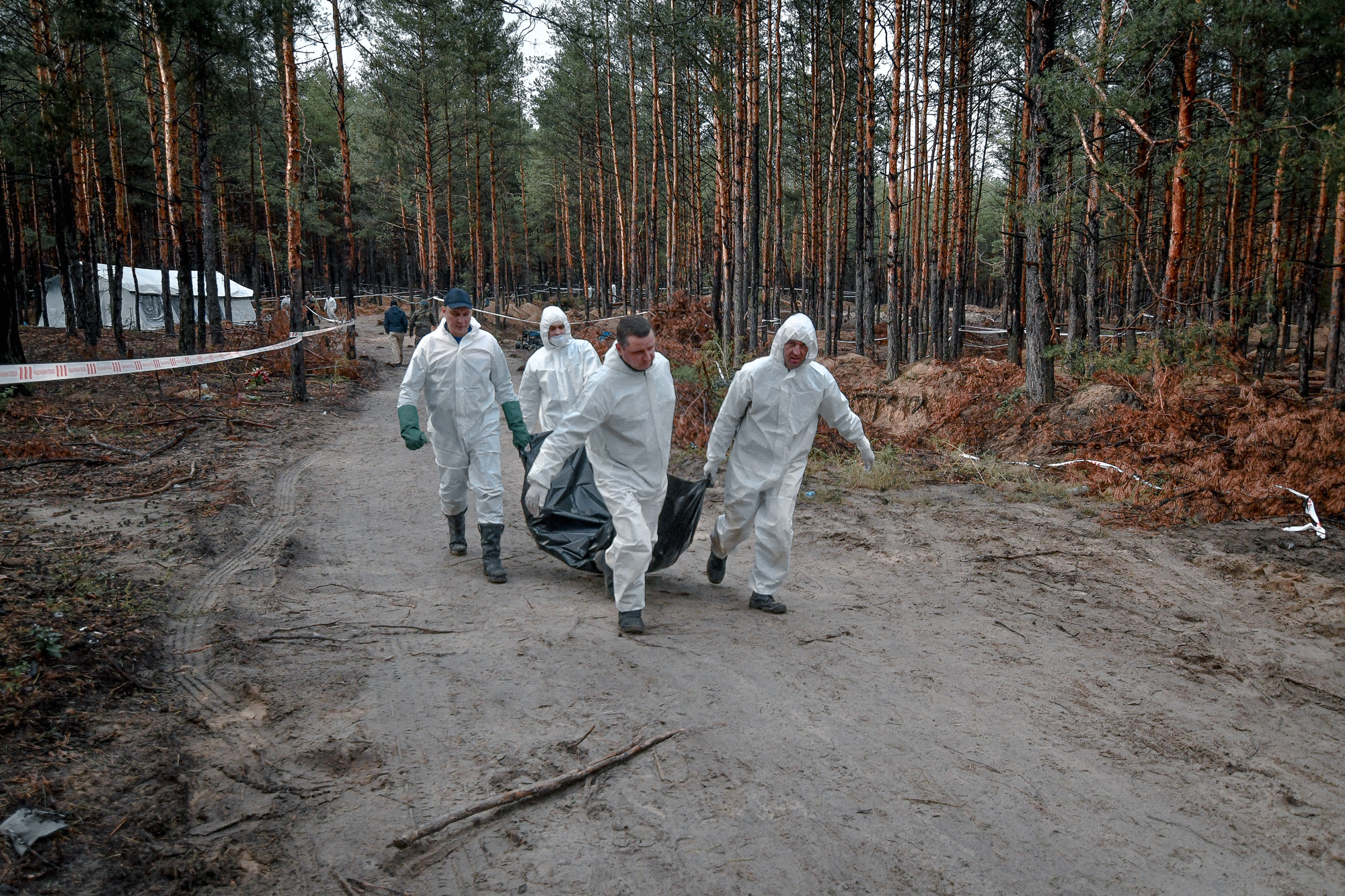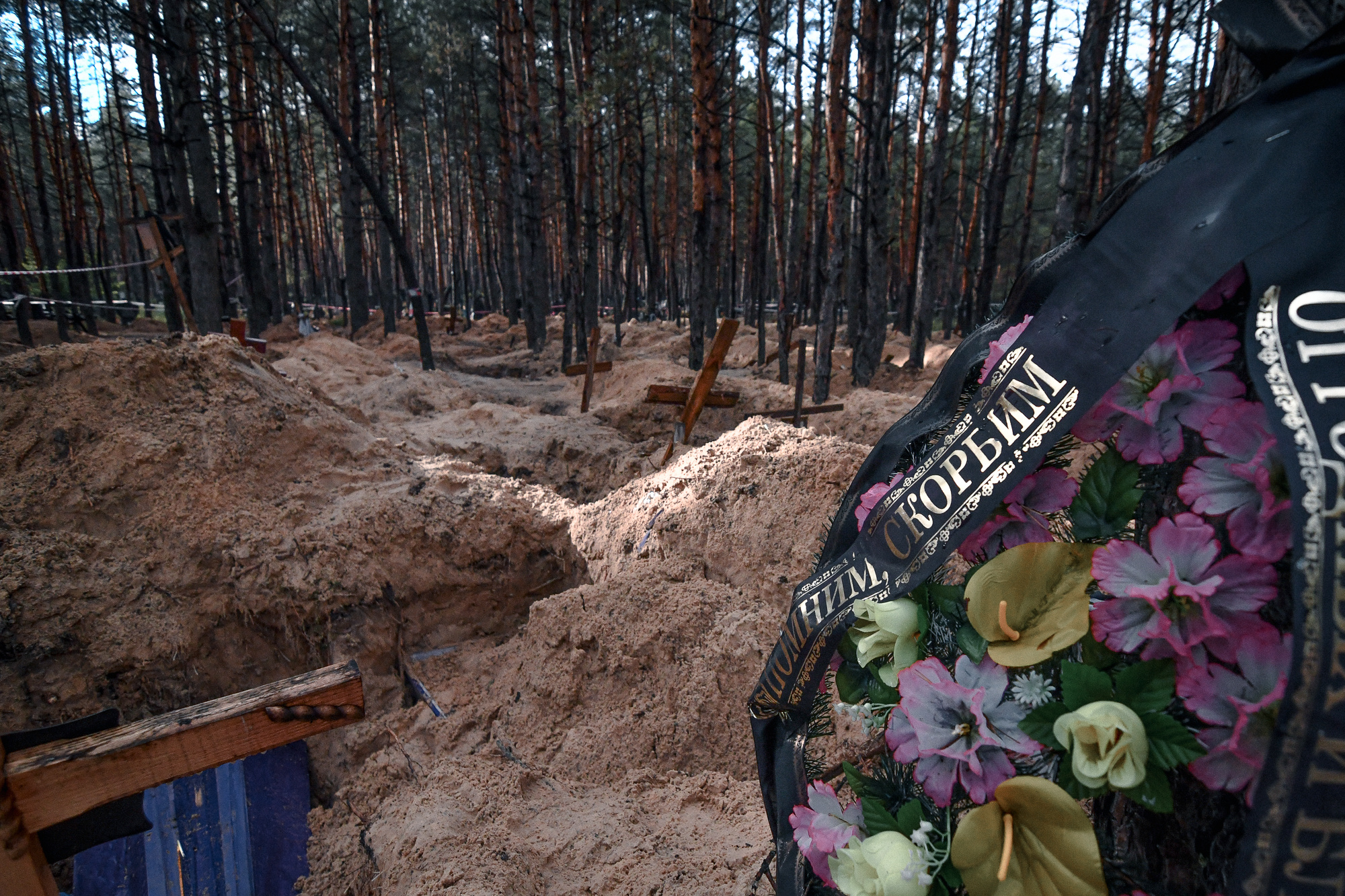First comes the scent of pine needles. The semi-sweet, rotten orange smell of corpses is a little later.
The most recently discovered mass grave of the Russo-Ukraine war is on the northern outskirts of Izyum, a town with a pre-war population of 45,000, in a modest forest. Russian Federation (RF) troops mostly from 144th Guards Motor Rifle Division attacked Izyum in early March, captured it on Apr. 1, and fled on September 10.
The Izyum paupers’ cemetery has no permanent fence or religious markings. It abuts a street with well-kept, brick and plaster single-family homes with neat gardens and solid tiled roofs that would not look out of place in a wooded suburb outside Belgrade or Sofia. Living near a city burial site was always a bit macabre, homeowner Vera Pyatishina told Kyiv Post, but the neighborhood was always quiet with plenty of birds and a few squirrels. In peacetime, she said, months might pass before the city morgue might sent a work crew for a new burial.
After the Russian army came to Izyum, the grave-diggers and their truck were in the forest almost daily, Pyatishina said.
The Armed Forces of Ukraine (AFU) offensive launched in early September in the Kharkiv sector has liberated, according to official Ukrainian sources, more than 50 towns and villages over more than 6,000 square kilometers of territory.
Residents in localities large and small across the region told Kyiv Post that wherever the Russian army came, within a few days, occupation authority officials would follow, knocking on doors in a hunt for people unfriendly to the invaders. Particularly targeted, eyewitnesses said, were Ukrainian law enforcers and civilian officials unwilling to collaborate with Russian authorities, former AFU service members, individuals with patriotic Ukrainian tattoos, and political activists.

N. Korean Troops Massed in Russia to Enter Ukraine War ’Soon’: Pentagon Chief
During their five-month occupation of Izyum, Kharkiv region senior investigator Serhiy Bolvinov said, Russian authorities buried 447 bodies at the grave site in the pine forest next to Pyatishina’s home. Of these, 194 were civilian men, 215 were women, 22 were military and 5 were children. Forensics teams haven’t yet determined the sex of another 11 bodies.
“Many of the dead are missing limbs, (were buried with) bound hands, (had) shrapnel wounds, head and chest injuries, missing genitals, broken ribs, stab wounds, penetrating bullet wounds, or ropes around the neck,” Bolvinov said in a statement.
Oleksandr Kopko, a resident of the town Kupiansk, to the north of Izyum, told Kyiv Post the detention teams looking for someone to “question” were usually accompanied by RF paramilitary police or armed Chechen fighters, and seemed to show up at homes during the night or early in the morning. In some cases, he said, occupation authorities accepted bribes to free a detained husband or son.
“But sometimes, they didn’t come back,” Kopko said.
Ukrainian authorities have accused Russian occupation troops of various crimes during the month-long occupation of Bucha, a town to the north of Kyiv. These include torturing and killing people for information about partisans or hidden valuables, murdering civilians wantonly, and using machine guns or even automatic cannons on people stepping out into the street. According to local authorities, 458 bodies have been recovered from graves around Bucha. Some were buried in gardens or under piles of trash.
At the Izyum cemetery, the graves are packed together in a space not much larger than a pair of football fields. Some of the dead were buried pointing north-south, some east-west, some individually, and some in threes or fours. There are no neat rows or gravestones. One gets the impression grave sites were selected based on space between the pine trees.
The village of Pisky is about a 10-minute drive north from the center of Izyum. During the occupation the Russians used Pisky as a central base in the region, commandeering several industrial compounds for storage and housing. Locals said Russian soldiers walked the village day and night.
Pisky shop owner Anna Tikhonova told Kyiv Post “everyone” in the village knew the occupation authorities were taking away citizens, but uniformed Russian soldiers in Pisky generally left civilians alone and “only looted a little.” The Russians paid with Ukrainian hryvnias – money they had certainly stolen, she said.
Tikhonova and others emphasized that the Russian Army’s seemingly wanton use of bombs and artillery against civilian structures probably killed more Ukrainians than Kremlin interrogators.
One of the worst-hit sectors of the entire Kharkiv region is Izyum’s central district, targeted in early March for a devastating series of RF air raids and heavy artillery rocket attacks. A Kyiv Post reporting team observed unexploded Russian 300mm RF rockets, among other Izyum locations, embedded in a children’s basketball court, in the courtyard of a bank, and deep inside the main city cemetery. No military target was visible, locals said, nor was there any within kilometers at the time of the strikes.
Kharkiv, Ukraine’s second largest city with a pre-war population of 1.4 million, wasn’t occupied by the Russians, but for months it was subjected to daily RF artillery. Ihor Terekhiv, the city’s mayor, told Kyiv Post that the death toll is impossible to know precisely, but certainly “much more than hundreds.” Even the initial effort to repair homes, businesses, government buildings, schools and hospitals blasted by everything from aerial bombs, fuel area explosives and artillery rockets will cost, at minimum, billions of dollars, Terekhiv said. More than 150,000 Kharkiv residents are homeless, he said.
In the village of Kozacha Lopan, some ten kilometers from the Russian border, the worst strikes came on the first day of the war, with Moscow’s artillery systematically pounding roads and the main railroad leading south and, seemingly, homes on high ground overlooking the international frontier.
Farmer Valya Meshnikova had nowhere to escape. She showed Kyiv Post the windowless home she and her three sons have been living in, without electricity, gas or water supply, since Russian shelling on Feb. 24. Her barn is roofless, her boys don’t have enough to eat, and one of her cows limps from a shell splinter.
“But at least we are alive … some of our neighbors died in the shelling, and it happened on every street (in Kozacha Lopan) … there’s no way to know how many people the Russians killed … and that’s just in our village.”
You can also highlight the text and press Ctrl + Enter












